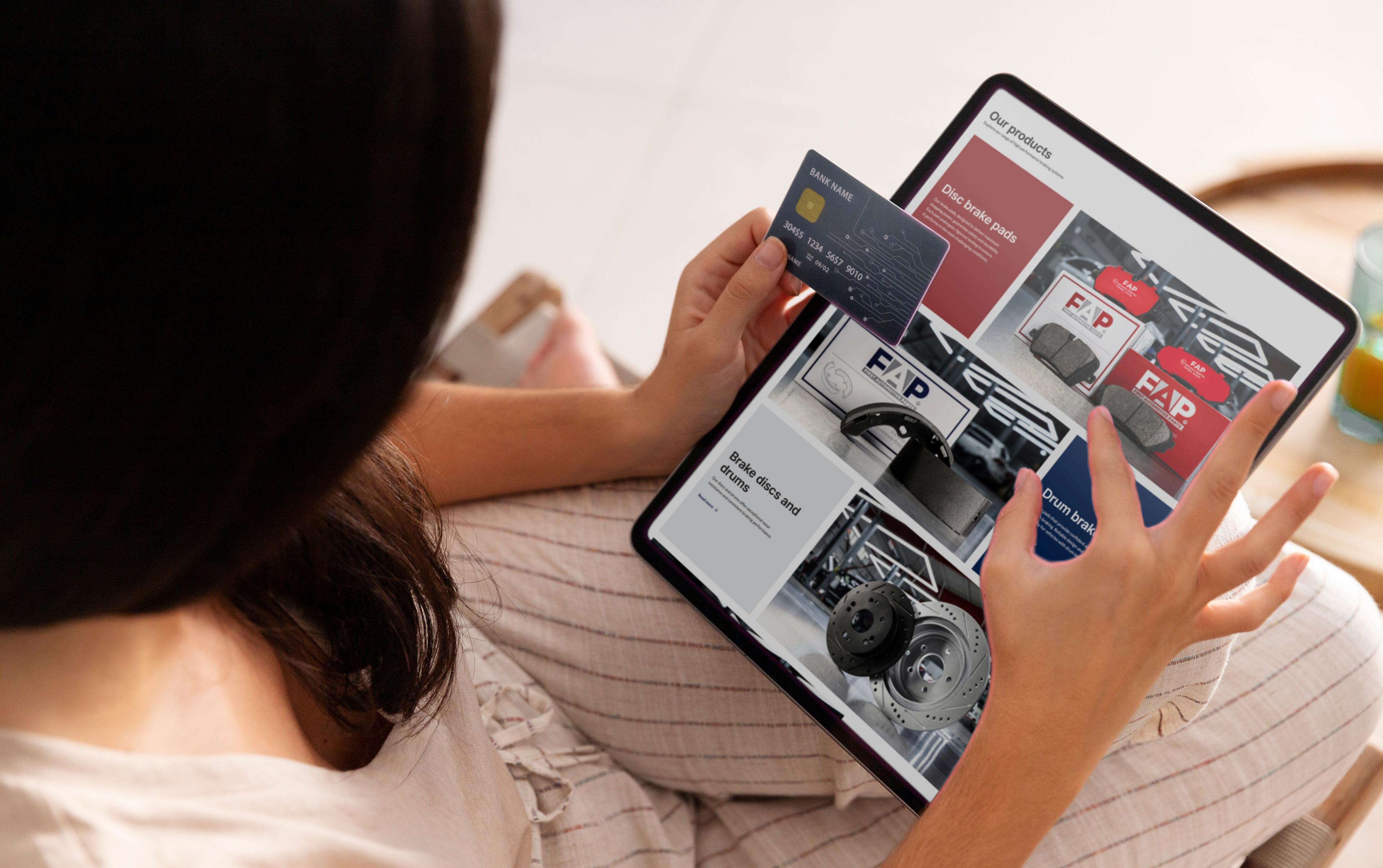What is UX design?
UX design stands for user experience design - in other words, the design of the user experience on digital products such as websites, apps or online stores. The aim is for users to find their way around a site quickly, feel comfortable and achieve their goals as easily as possible - for example, to complete a purchase, find information or fill out a contact form.
It's not just about the appearance (design), but about the overall experience: How clear is the navigation? How quickly does the page load? How logical is the structure? UX design thinks from the user's perspective and combines technology, psychology, design and structure. Investing in good UX design not only increases satisfaction and loyalty, but also the conversion rate and trust in the brand.
What is bad UX design?
Technical and structural weaknesses in UX design
Poor UX design often manifests itself first on a technical level: if a website loads slowly, users quickly lose patience - especially on mobile devices. Delays in page loading not only look unprofessional, they also reduce visibility in search engines, as loading time is a direct ranking factor. A lack of accessibility is just as problematic: if contrasts, alternative texts or keyboard accessibility are missing, user groups are excluded - resulting in frustration and bounces. But the structure of the website is also crucial. If menus are illogically structured, content is duplicated or the design varies greatly between pages, disorientation occurs. Visitors do not know where to click, cannot find information straight away and leave the site more quickly than they would like. A clear, uniform page structure with comprehensible navigation is therefore the basis of any positive user experience.
Content weaknesses and a lack of user guidance
Weak UX design can also deter users in terms of content. Missing or poorly placed calls to action make it difficult for visitors to take the next step - be it making an inquiry, buying a product or registering. Without clear calls to action, there is a lack of direction, which results in potential customers leaving. A website that only provides factual information but does not create an emotional connection is equally unconvincing. Good UX thrives on storytelling - linking content with experiences, values and a clear message. This is the only way to create an overall impression that will be remembered. If this common thread is missing and content seems interchangeable, the effect will be lost. Poor UX design is therefore not just a question of technology, but also of communication - and is a decisive factor in whether visitors stay or leave.
Typical signs of poor UX design
Recognize conspicuous user signals
A poor user experience can often be seen directly in the behavior of visitors. A high bounce rate is a clear warning signal: users enter the page and leave it again immediately without interacting - usually due to unclear content, overloaded design or long loading times. A short dwell time also shows that users are not finding what they are looking for or feel overwhelmed by the page layout.
Weak conversion and lack of orientation
If many visitors come but only a few make an inquiry, fill out a form or buy something, this is often due to poor user guidance. A low conversion rate can be caused by poorly placed or unclear call-to-actions, forms that are too long or a lack of trust. It is just as critical if calls to action are not even noticed or used. UX design should ensure that such elements are visible, clear and motivating.
Cancellations and support requests as warning signals
Aborted processes are also a clear sign of weak UX - for example, when users start a contact form but do not complete it. This is often due to too many hurdles, a lack of help or uncertainty. Poor UX is also reflected in frequent support requests: if visitors regularly ask the same questions or cannot find their way around, the website is not intuitive enough. A user-friendly site should be largely self-explanatory and offer guidance without external help.
Optimize website loading time
Slow loading times often have several causes that interact. Frequently, the image files are too large and have not been compressed, which takes up a lot of storage space and loading time. Unnecessary or poorly optimized scripts and plugins can also have a significant impact on website performance. If the server also works slowly or is overloaded by too many requests, the page load is further delayed. The problem is exacerbated further if there are no caching mechanisms to store content temporarily and deliver it repeatedly and quickly. Excessive redirects - i.e. detours that users and search engines have to take - also contribute to the site becoming noticeably slower.
Practical measures to improve loading time
There are several effective measures that work together to improve the loading time of your website. One important step is image optimization: modern formats such as WebP and lossless compression can significantly reduce the size of image files without losing quality. The use of lazy loading is also recommended - images and videos are only loaded when they actually appear in the user's field of vision, which significantly reduces the start time of the page. A lot can also be optimized in the source code: By minimizing CSS and JavaScript files and removing unnecessary scripts, the amount of data is reduced and the page loads faster. Caching is another lever: activated browser caching makes it possible to provide returning visitors with content more quickly as it has been cached. Last but not least, server performance plays a key role: a high-performance hosting provider with a modern infrastructure ensures that your website can be accessed quickly and stably. All of these measures together help to sustainably improve performance.
Clear website structure for better user guidance + SEO
A well thought-out website structure is essential so that users can find their way around quickly and Google can index your content better. A clear hierarchy, logical navigation and consistent page layout are crucial.
Elements of an optimal website structure
A well-structured website starts with clear navigation. The main menu should be clearly structured and contain logical categories and suitable subcategories so that users can immediately recognize where they can find relevant content. In addition, breadcrumbs - small navigation paths - help to make the current location within the website hierarchy visible. This allows users to see where they are at any time and switch between levels more easily. Well thought-out internal linking is also crucial: by linking related pages together in a meaningful way, not only is orientation improved for visitors, but search engines can also find them more easily. An XML sitemap also ensures that all important pages are indexed correctly and can therefore appear in the search results. To ensure smooth operation on mobile devices, menus should be designed responsively - i.e. in such a way that they automatically adapt to different screen sizes and are easy to operate with a finger. All of these elements together help to make the structure of your website user-friendly and search engine-friendly.
Example: Structure of a successful website
A well thought-out page structure starts with a clear main navigation, which contains central areas such as the homepage, products, category A, category B, about us, blog and contact. Each of these categories fulfills a clear function and helps the user to find their way around quickly. It is particularly important that each category leads to precisely structured subpages - such as individual product pages that are clearly structured, well described and internally linked. This creates a logical, comprehensible structure that not only improves user guidance, but is also rated positively by search engines. This type of site architecture creates trust and makes it easier for visitors to find exactly what they are looking for.
Targeted implementation of an accessible website
Accessibility means that your website is accessible to people with disabilities. This includes visually impaired, hearing impaired, motor impaired users and more. An accessible website not only improves the user experience for everyone, but is a legal requirement in many countries.
Important aspects of accessibility
An accessible website takes into account the needs of all users - regardless of limitations or technical requirements. A key aspect here is visual accessibility: Sufficient color contrast between text and background as well as scalable font sizes ensure that content can also be easily recognized by people with visual impairments. Equally important are alternative texts for images so that screen readers can reproduce the visual content correctly. Navigation must also be designed to be inclusive - this means that all functions must be fully operable using the keyboard without the need for a mouse. For audiovisual content such as videos or podcasts, subtitles and transcripts are essential so that people with hearing or speech impairments can also access the information. Last but not least, there should be no fixed time limits for entries - users need to be able to complete forms or processes at their own pace. All of these measures help to ensure that your website is truly accessible to all - while also improving usability and the overall user experience.
Advantages of accessible websites
Accessibility on websites not only gives more people access to digital content, but also brings concrete benefits for companies. It opens up new target groups, such as people with disabilities or older users who rely on a clear structure and good readability. At the same time, barrier-free implementation often automatically improves SEO - through clean, semantic code and a logical page structure. It also strengthens the brand image, because those who take digital participation seriously demonstrate social responsibility and position themselves as a modern, customer-oriented company.
Use storytelling specifically for a better user experience
Storytelling is a powerful tool for engaging visitors emotionally and bringing your brand to life. A website that tells stories is memorable and motivates users to engage more intensively with your offers.
Elements of successful storytelling
Storytelling works particularly well on a website when the message is clear. Users should immediately understand what it is about and what the brand or company wants to convey. Visual elements such as images, videos and graphics help to bring this story to life and make it emotionally tangible. They not only support understanding, but also create atmosphere.
For content to be captivating, it needs structure. A good arc of suspense with an introduction, main section and conclusion ensures that visitors stick with it and remember it better. Authenticity is particularly important here. Authentic, credible content creates trust and makes the brand tangible - exactly what makes for strong user loyalty.
Practical example: Storytelling on a company website
A start-up could tell the founder's story, describe challenges and successes and thus create a personal connection. Customer references and case studies complement the story and show the benefits of the products.
How Google Analytics improves your UX design based on data
Google Analytics provides valuable data about the behavior of your users. These findings help to identify weaknesses in the UX design and make targeted improvements.
Important metrics for UX analysis
Google Analytics can be used to record important key figures that provide direct information about the quality of the user experience. The bounce rate shows how many visitors leave the page without interacting with it - a clear sign of possible weaknesses in the structure or content. The dwell time measures how long users stay on a page. If it is short, there may be a lack of relevance or orientation. The number of pages per session is also informative: the more pages a user visits, the better the user guidance usually works. Finally, the conversion rate shows how many users perform a desired action - such as sending an inquiry or completing a purchase. Last but not least, the loading times provide information about the technical performance: slow pages not only slow down visitors, but also have a negative impact on the overall user experience. All this data helps to identify specific weak points and continuously improve the UX design.
Practical application of Google Analytics data
To improve the user experience in a targeted manner, it is worth taking a closer look at the pages with a particularly high bounce rate. These areas indicate where users do not find what they expect or do not feel addressed. The next step is to check the call to actions. They should be clearly visible, clearly formulated and attractively designed so that users know what they should do next. To find out which design works best, A B tests are helpful. Two versions of a page are compared with each other to see which performs better. In addition, Google Analytics offers a helpful overview of the typical paths that visitors take through the website with the user flow - including the points at which they exit. These findings form the basis for targeted improvements in UX design.
Call to Action (CTA) optimieren
Features of effective CTAs
Call to actions are a central element in UX design, as they guide users to a desired action - whether a purchase, inquiry or newsletter registration. To fulfill this function, they must be clearly visible. Users should recognize them at first glance without having to search for a long time. Clear and action-oriented language such as "Buy now" or "Try for free" makes it clear what happens next. In addition, a high-contrast design ensures that the CTA stands out visually from the rest of the design. Placement is also crucial: CTAs can be particularly effective at the end of a text, in the navigation or as a targeted pop-up. In this way, they actively help to increase the conversion rate and guide users safely through the website.
Tipps zur CTA-Optimierung
- Testen Sie verschiedene Texte, Farben und Positionen.
- Vermeiden Sie zu viele CTAs auf einer Seite, um Nutzer nicht zu überfordern.
- Nutzen Sie Dringlichkeit oder Exklusivität („Nur noch heute verfügbar“).
- Verknüpfen Sie CTAs mit klaren Nutzenversprechen.
Conclusion
Recognizing poor UX design and making targeted improvements is a complex but rewarding process. By optimizing the website load time, creating a clear website structure, designing your site to be accessible, using storytelling to create emotional appeal, using Google Analytics for analysis and implementing effective call-to-actions, you can create a website that inspires visitors and convinces search engines.
These measures not only lead to better user satisfaction, but also to more customers and higher visibility on Google. UX design is therefore not a nice-to-have, but a decisive success factor for your digital presence.



